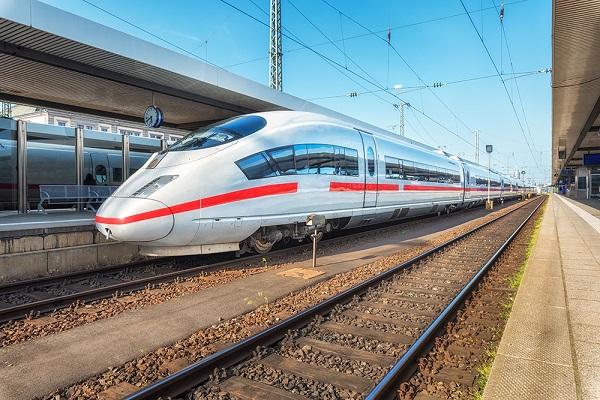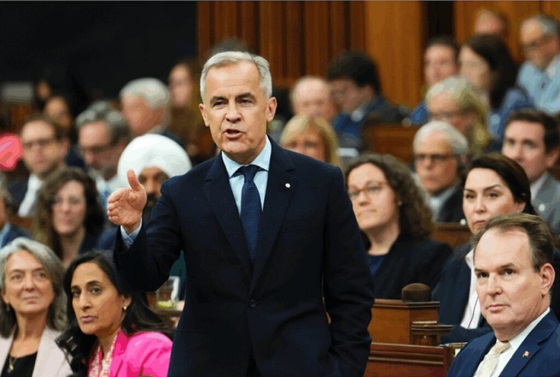Energy
Energy notes from the edge: Coal trains vs high speed rail

From the Frontier Centre for Public Policy
Author Terry Etam is a columnist with the BOE Report
They are accusing you of murdering people by producing fuel the world requires for survival. It’s silly; they (the NDP) have things precisely backwards – they are confused by the role of hydrocarbons in our life. So you need to address that first and foremost, because they are writing policy based on such faulty reasoning.
They are NOT asking you to produce your product better. They are saying you are killing the planet and its people and making a fortune while doing so.
Ah, you couldn’t make this stuff up, as we find ourselves saying on a daily basis.
Here’s a look at two ambitious infrastructure projects involving rail construction, separated by a few years and also by about everything else two projects could be separated on. One of the train stories dates way back to 2019; let me take you back to that era for all the readers less than five years old (not quite but close; last week I met a delightful family, a mother and two young daughters that are fascinated by pump jacks, love taking pictures of them, and are planning to launch an apparel line adorned by nodding donkeys. I’ll take five.) 2019 was the zenith of anti-hydrocarbon frenzy. It remains alive in small pockets of guilt-ridden billionaire inheritors and various political types that don’t understand energy and don’t want to learn, but 2019 was something else; hundreds of thousands of brainwashed children taking to the streets behind a strange Swedish kid that was treated like a messiah by confused adults. Canada’s prime minister jauntily joined one of her protests, standing proudly in front of signs explaining in emotional gobbledygook that the hydrocarbons that were keeping the sign-holders alive now and for the foreseeable future had to be eradicated immediately via some demand or magic or else the world will simply explode into flames a few decades hence.
Anyway, it was all surreal in one sense, but back to the railways: a few interesting milestones were hit around then that, when viewed alongside the climate hysteria of the era, prove without a doubt just how challenging it will be to transition to a new energy system.
But before getting to the 2019 story, we’ll check in on one that began long before then and continues to this day. It hails from sunny California, spiritual leader of the Movement To Use Extreme Wealth To Do Wacko Things. In 2008, voters approved a high-speed rail connection between Los Angeles and San Francisco, to be completed by 2020, at a cost of some $33 billion. Big numbers, both on the timescale and in the $ department. That’s reality these days though; nothing is easy or cheap, part of which is the price of going green. US energy transition advocates have reliably pointed out that high speed rail was a necessity all over the US, and the world for that matter. Nature website ran an article stating “…the role of high-speed railways in fostering a transition towards sustainable energy sources has gained prominence… these findings highlight the environmentally friendly attributes of high-speed railways and underscore the pressing need for effective policy measures to facilitate a global transition towards renewable energy, both in China and worldwide.”
A few interesting tidbits emerge out of this scenario. The first and most peculiar is that a scientific article on the scientific website Nature would assert that high-speed rail is important in “fostering a transition towards sustainable energy sources” – the statement has no logical basis, it flows from nothing, and is incoherent. HSR is wonderful, and makes efficient use of time, and possibly could replace air travel in some circumstances, and, as the paper rightly asks, HSR may well contribute to ‘nationwide energy savings and emissions reductions’. But none of these virtues foster a transition towards sustainable energy sources and to state it does is an oddly dumb non sequitur to feature as the anchor statement for an academic paper.
But anyways, whatever, the paper analyzes China’s experiences with HSR, which brings up a far more interesting point about the energy transition that is in the realm of That Which Must Not Be Discussed: the fact that in the west, major infrastructure projects are incredibly difficult to construct, whether green or not, and that initial cost estimates often turn out to be laughably low.
California did indeed set out to build an HSR in 2008, to be completed (as you may recall) some twelve years hence. But, as this California news website notes, “the blueprint is fraying”, which is some beautiful understatement. In 2020, the year the project was to be completed, Governor Newsom unveiled an updated plan, that California would settle for building a 171 mile initial segment – about a third of the distance of the original – at a cost of $35 billion, a number that exceeds the initial estimate for the entire 500 mile line. And the in-service date for the shortened version is now penciled in as 2030. As for an end date for the entire project, they haven’t a clue, don’t even bother taking a guess at it, but they have bravely provided an updated budget of, brace yourself, $128 billion. That’s almost four times the original estimate.
And even that number is scoffed at by engineers that have worked on HSRs. Bill Ibbs, a retired UC Berkeley engineer, says he is concerned about the lack of attention to engineering risks – that proponents don’t even address significant engineering challenges in the latest cost estimate, such as challenges likely to arise in the 38 miles of mountain tunnels required. (Per the article linked above: “Democratic leaders have declined or did not respond to requests for interviews.” Who saw that coming.)
That is what we are in store for in the western world. Keep this example in mind the next time you hear about net-zero 2050 visions based on almost any large scale infrastructure construction. You would have to be the world’s most naïve person to believe initial cost and time estimates.
Now, on the other hand, countries such as China have indeed made great progress though, as we’ll see in a second, the choice of China as an example is fairly ironic. The Nature academic paper notes that hundreds of Chinese cities already operate HSR networks. China has stunned the world with the pace at which it has developed infrastructure over the past 40 years; however, it is an authoritarian state that sweeps aside the sort of issues that bog down western democracies like a bear sweeps aside a hiker.
And if we’re going to marvel at the speed at which China has constructed these HSRs, then we should look at this one too. In 2019, China opened a brand new, 1,813 mile railroad, completed on schedule at a cost of $28 billion. It took 4 years to construct, and faced multiple significant challenges such as “crossing both the Yangtze and Yellow Rivers twice” and includes 770 bridges and 229 tunnels totalling 469 kilometres or 291 miles, some 8 times as many tunnel miles as California. This new rail line is dedicated to carrying… coal. It was created for no other reason. It was built entirely to handle coal.
That’s how they do it folks. An authoritarian state that removes any obstacles instantly, all to build a supply line for a fuel that the west is cleansing itself from as fast as it can. China realizes what it takes to build things. The West does not. Further, while China is the largest installer of renewable energy, it is fairly transparent about its appetite for any fuel. That’s how the world works, folks, except for some…
“How do you sleep at night?” Or… how to win a debate with extremist loons – hand them a microphone.
An NDP committee that hates things dragged a bunch of “Big Oil” (or “Big Canadian Oil”, anyway) CEOs onto the carpet to, literally, blame them for forest fires and floods. Their argument went about where you’d think it would, when your philosophical underpinnings are of that grade: Not only do you mooks create a lot of bad weather, but you line your pockets by doing so, gleefully so, and thus we want to know just how you can sleep at night.
The CEOs responded decently enough in their polished way, but I think it’s important when addressing an interrogation of that sort to firmly call out the lay of the land.
Rich Kruger, CEO of Suncor, said “I could praise the transformational virtues of hydrocarbons over the past century, convey the world’s dependence on oil and gas for decades to come, recite economic contributions to Canada’s prosperity and, yes, discuss the concerning effects of climate change and GHG emissions… however, today, I plan to dispel a series to myths. And paint a picture of opportunity.” The myths: oil & gas prosperity comes at the expense of the planet; Canadian companies are resisting the energy transition/decarbonization; and that Canada can demonstrate global leadership by restricting its oil & gas sector.
He’s not wrong, but there’s a significant subtlety that gets swept under the rug here, one that can cause grave danger to a lot of people.
First, y’all need to understand the battlefield. Kruger is right; it is to generate headlines, but consider the headlines carefully when selecting which myths to bust. They (the NDP) are literally accusing the hydrocarbon industry of murder – not with a gun, but via creating the emissions that cause weather disasters that kill people. They and their fellow warriors have created a lazy but sellable chain of causality there.
Mythbusting is important, but first, it is critical to take aim at the cornerstones of their argument, and not capitulate on those. In other words:
- If someone accuses you of killing a bunch of people, might I suggest that saying “Yeah, well, we pay a lot of taxes…” is a losing strategy?
- If someone accuses you of killing a bunch of people, might I suggest that saying “Don’t worry, I’m taking measures to mitigate how many people I kill.” is also a losing strategy?
- Absolutely speak of emissions reduction improvements and any efforts made towards an energy transition – but don’t ignore the emotional point they use, when it undercuts everything else you say.
They are accusing you of murdering people by producing fuel the world requires for survival. It’s silly; they (the NDP) have things precisely backwards – they are confused by the role of hydrocarbons in our life. So you need to address that first and foremost, because they are writing policy based on such faulty reasoning.
They are NOT asking you to produce your product better. They are saying you are killing the planet and its people and making a fortune while doing so.
Their army of lawyers, with literally nothing better to do (hello, Sierra Club/Environmental Defense/EcoJustice/ad infinitum) are running circles around your lawyers. You are facing an army of extremely well-funded legal guerillas. You need to recognize their weapons. You are fighting against rifles with a diorama of your decarbonization efforts.
Here is the answer that addresses the inanity of the question in a simple and fool-proof way, which will do the trick, because they will have no answer: Hydrocarbon production enables life as we know it. Without hydrocarbon production, most of the earth’s 8 billion people will not survive a year. Hydrocarbon production feeds those people in a way that nothing else can. Hydrocarbon production keeps countless people from freezing to death, every year, like nothing else at present can. Hydrocarbon production provides the building blocks for our modern medical system, our transportation system, and almost any other thing within arm’s length.
Hydrocarbon production enables life, and it will do so for decades until a suitable replacement arrives on the scene that can not just match, but beat hydrocarbons for energy density, reliability, and cost. That will most likely happen some day. But to attempt to strangle today’s fuel system without a replacement is a clearer path to willfully causing human death than is the production of the fuel that keeps us alive.
There are multiple excellent pathways a hydrocarbon company can go down to show the public they are validly concerned about the environment, such as eliminating spills, eliminating pollution of all sorts, or respecting and revitalizing natural habitats.
But when you tell them how eagerly you are ‘decarbonizing’, you forfeit the match. Your product is carbon. That is literally the murder weapon they place in your hands.
The impact on humanity from more carbon in the air, whatever the consequences may be, pales in comparison – by an astounding degree – to what the impact on humanity would be if oil and gas production were to cease.
Mr. Kruger touched on the most important part, but then skipped right over it: the “transformational virtues of hydrocarbons over the past century”, as a phrase, skips right over the entire arc of the human benefits brought through the industrial revolution, treating them as secondary aspect that needs to take a back seat to convincing the world that Canadian companies really are trying to decarbonize.
And let’s be clear about that whole idea: anyone that places decarbonization as the number one priority should drop whatever they’re doing to get out and make nuclear energy happen here, there, and everywhere, because that’s the only game in town as far as a global, achievable solution goes. I don’t have a problem with that. I love cheap, clean energy, available reliably and in abundance. And almost every global citizen would agree with those four, but more importantly would prefer all four, of those characteristics. People don’t love oil & gas. They love what it can do. Want to replace them? Then it has to be better in every functional way.
While the fate of oil/gas on the global stage will be determined by billions who know how much they need it, the emotional messaging of the NDP et al nevertheless has the power to shape legislation, for example to sneakily introduce climate reporting requirements into financial statements and thereby open the door to countless lawsuits – lawsuits which the industry will be forced to defend. And those singular-function activist-lawyers will eat you alive if you are sitting at the table agreeing about the need to rapidly decarbonize.
The messaging should be that humanity requires oil and gas and will for decades, and that role of industry is to do this as cleanly and efficiently as possible. That might sound like a subtle distinction compared to a pledge to decarbonize asap, but it’s not – it’s the difference between a bullet missing you by an inch and not.
The reason you need to think this way is because hydrocarbons will remain standing for a very long time as a fundamental source of energy, as is witnessed by the sheer global force of increasing consumption of every type of energy (see: New Zealand completely backtracking on an oil & gas exploration ban once it dawned on them that existing fields deplete – coming soon to governments everywhere)… But Western energy leaders may get seriously wounded by the sheer legal might of the enemies faced at such panels, and by the minions they inspire, as bombastically comical as it might appear on the surface.
Terry Etam is a columnist with the BOE Report, a leading energy industry newsletter based in Calgary. He is the author of The End of Fossil Fuel Insanity. You can watch his Policy on the Frontier session from May 5, 2022 here.
Energy
Liberals Twisted Themselves Into Pretzels Over Their Own Pipeline MOU

From Energy Now
By Margareta Dovgal
Playing politics with pipelines is a time-honored Canadian tradition. Recent events in the House of Commons offered a delightful twist on the genre.
The Conservatives introduced a motion quoting the Liberals’ own pipeline promises laid out in the Memorandum of Understanding (MOU) with Alberta, nearly verbatim. The Liberals, true to form, killed it 196–139 with enthusiastic help from the NDP, Bloc, and Greens.
We all knew how this would end. Opposition motions like this never pass; no government, especially not one led by Mark Carney, is going to let the opposition dictate the agenda. There’s not much use feigning outrage that the Liberals voted it down. The more entertaining angle has been watching closely as Liberal MPs twist themselves into pretzels explaining why they had to vote “no” on a motion that cheers on a project they claim to support in principle.
Liberal MP Corey Hogan dismissed the motion as “game-playing” designed to “poke at people”.
And he’s absolutely right to call it a “trap” for the Liberals. But traps only work when you walk into them.
Indigenous Services Minister Mandy Gull-Masty deemed the motion an “immature waste of parliamentary time” and “clearly an insult towards Indigenous Peoples” because it didn’t include every clause of the original agreement. Energy Minister Tim Hodgson decried it as a “cynical ploy to divide us” that “cherry-picked” the MOU.
Yet the prize for the most tortured metaphor goes to the prime minister himself. Defending his vote against his own pipeline promise, Carney lectured the House that “you have to eat the entire meal, not just the appetizer.”
It’s a clever line, and it also reveals the problem. The “meal” Carney is serving is stuffed with conditions. Environmental targets or meaningful engagement with Indigenous communities aren’t unrealistic asks. A crippling industrial carbon price as a precondition might be though.
But the prime minister has already said the quiet part out loud.
Speaking in the House a few weeks ago, Carney admitted that the agreement creates “necessary conditions, but not sufficient conditions,” before explicitly stating: “We believe the government of British Columbia has to agree.”
There is the poison pill. Handing a de facto veto to a provincial government that has spent years fighting oil infrastructure is neither constitutionally required nor politically likely. Elevating B.C.’s “agreement” to a condition, which is something the MOU text itself carefully avoids doing, means that Carney has made his own “meal” effectively inedible.
Hodgson’s repeated emphasis that the Liberal caucus supports “the entire MOU, the entire MOU” only reinforces this theory.
This entire episode forces us to ask whether the MOU is a real plan to build a pipeline, or just a national unity play designed to cool down the separatist temperature in Alberta. My sense is that Ottawa knew they had to throw a bone to Premier Danielle Smith because the threat of the sovereignty movement is gaining real traction. But you can’t just create the pretense of negotiation to buy time.
With the MOU getting Smith boo’ed at her own party’s convention by the separatists, it’s debatable whether that bone was even an effective one to throw.
There is a way. The federal government has the jurisdiction. If they really wanted to, they could just do it, provided the duty to consult with and accommodate Indigenous peoples was satisfied. Keep in mind: no reasonable interpretation equates Section 35 of the Charter to a veto.
Instead, the MOU is baked with so many conditions that the Liberals have effectively laid the groundwork for how they’re going to fail.
With overly-hedged, rather cryptic messaging, Liberals have themselves given considerable weight to a cynical theory, that the MOU is a stalling tactic, not a foundation to get more Canadian oil to the markets it’s needed in. Maybe Hodgson is telling the truth, and caucus is unified because the radicals are satisfied that “the entire MOU” ensures that a new oil pipeline will never reach tidewater through BC.
So, hats off to the legislative affairs strategists in the Conservative caucus. The real test of Carney’s political power continues: can he force a caucus that prefers fantasy economics into a mold of economic literacy to deliver on the vision Canadians signed off on? Or will he be hamstrung trying to appease the radicals from within?
Margareta Dovgal is managing director of Resource Works Society.
Daily Caller
Paris Climate Deal Now Decade-Old Disaster


From the Daily Caller News Foundation
By Steve Milloy
The Paris Climate Accord was adopted 10 years ago this week. It’s been a decade of disaster that President Donald Trump is rightly trying again to end.
The stated purpose of the agreement was for countries to voluntarily cut emissions to avoid the average global temperature exceeding the (guessed at) pre-industrial temperature by 3.6°F (2°C) and preferably 2.7°F (1.5°C).
Since December 2015, the world spent an estimated $10 trillion trying to achieve the Paris goals. What has been accomplished? Instead of reducing global emissions, they have increased about 12 percent. While the increase in emissions is actually a good thing for the environment and humanity, spending $10 trillion in a failed effort to cut emissions just underscores the agreement’s waste, fraud and abuse.
As a nonprofit, we are dependent on the generosity of our readers.
Please consider making a small donation of any amount here.
Thank you!
But wasting $10 trillion is only the tip of the iceberg.
The effort to cut emissions was largely based on forcing industrial countries to replace their tried-and-true fossil fuel-based energy systems with not-ready-for-prime-time wind, solar and battery-based systems. This forced transition has driven up energy costs and made energy systems less reliable. The result of that has been economy-crippling deindustrialization in former powerhouses of Germany and Britain.
And it gets worse.
European nations imagined they could reduce their carbon footprint by outsourcing their coal and natural gas needs to Russia. That outsourcing enriched Russia and made the European economy dependent on Russia for energy. That vulnerability, in turn, and a weak President Joe Biden encouraged Vladimir Putin to invade Ukraine.
The result of that has been more than one million killed and wounded, the mass destruction of Ukraine worth more than $500 billion so far and the inestimable cost of global destabilization. Europe will have to spend hundreds of billions more on defense, and U.S. taxpayers have been forced to spend hundreds of billions on arms for Ukraine. Putin has even raised the specter of using nuclear weapons.
President Barack Obama unconstitutionally tried to impose the Paris agreement on the U.S. as an Executive agreement rather than a treaty ratified by the U.S. Senate. Although Trump terminated the Executive agreement during his first administration, President Joe Biden rejoined the agreement soon after taking office, pledging to double Obama’s emissions cuts pledge to 50 percent below 2005 levels by 2030.
Biden’s emissions pledge was an impetus for the 2022 Inflation Reduction Act that allocated $1.2 trillion in spending for what Trump labeled as the Green New Scam. Although Trump’s One Big Beautiful Bill Act reduced that spending by about $500 billion and he is trying to reduce it further through Executive action, much of that money was used in an effort to buy the 2024 election for Democrats. The rest has been and will be used to wreck our electricity grid with dangerous, national security-compromising wind, solar and battery equipment from Communists China.
Then there’s this. At the Paris climate conference in 2015, U.S. Secretary of State John Kerry stated quite clearly that emissions cuts by the U.S. and other industrial countries were meaningless and would accomplish nothing since the developing world’s emissions would be increasing.
Finally, there is the climate realism aspect to all this. After the Paris agreement was signed and despite the increase in emissions, the average global temperature declined during the years from 2016 to 2022, per NOAA data.
The super El Nino experienced during 2023-2024 caused a temporary temperature spike. La Nina conditions have now returned the average global temperature to below the 2015-2016 level, per NASA satellite data. The overarching point is that any “global warming” that occurred over the past 40 years is actually associated with the natural El Nino-La Nina cycle, not emissions.
The Paris agreement has been all pain and no gain. Moreover, there was never any need for the agreement in the first place. A big thanks to President Trump for pulling us out again.
Steve Milloy is a biostatistician and lawyer. He posts on X at @JunkScience.
-

 Community2 days ago
Community2 days agoCharitable giving on the decline in Canada
-

 Business1 day ago
Business1 day agoCanada’s recent economic growth performance has been awful
-

 Alberta1 day ago
Alberta1 day agoCanada’s New Green Deal
-

 Alberta1 day ago
Alberta1 day agoAlberta’s huge oil sands reserves dwarf U.S. shale
-

 armed forces1 day ago
armed forces1 day agoOttawa’s Newly Released Defence Plan Crosses a Dangerous Line
-

 Health1 day ago
Health1 day agoSaskatchewan woman approved for euthanasia urged to seek medical help in Canada rather than US
-

 Indigenous1 day ago
Indigenous1 day agoResidential school burials controversy continues to fuel wave of church arsons, new data suggests
-

 Daily Caller1 day ago
Daily Caller1 day agoParis Climate Deal Now Decade-Old Disaster






